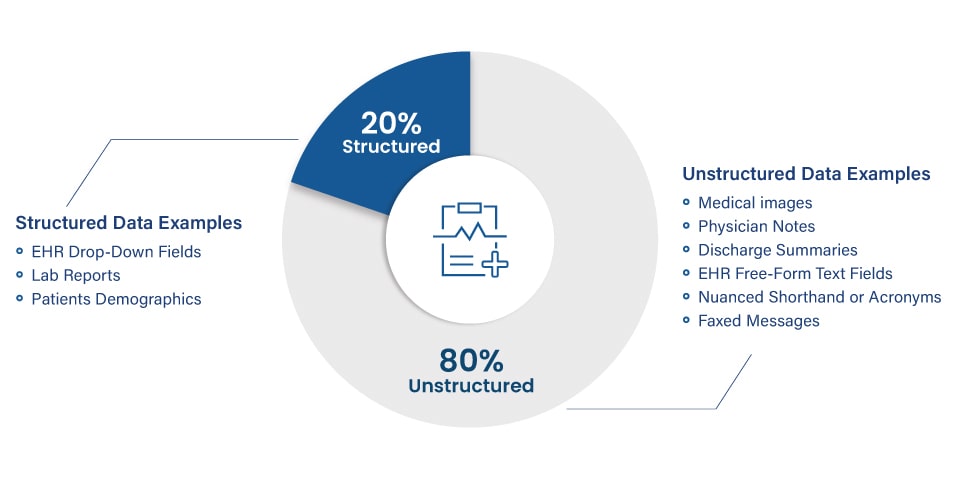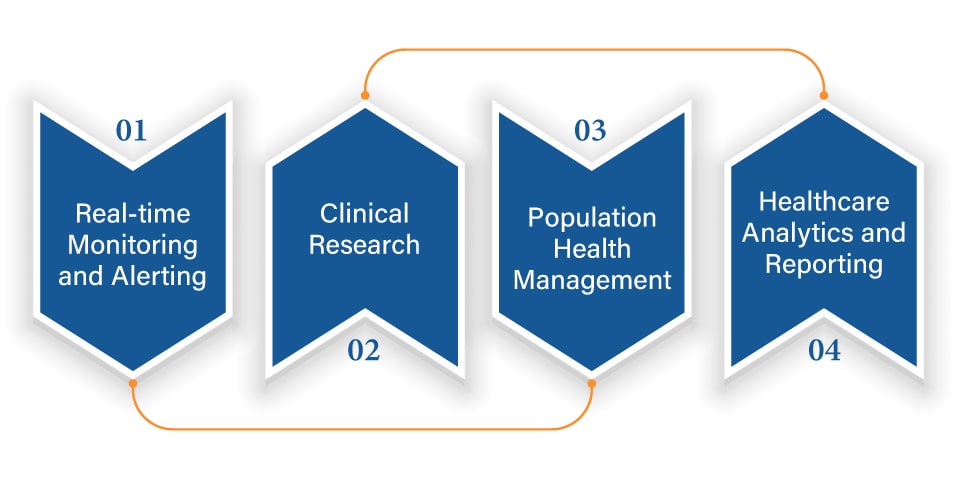After COVID-19, the healthcare sector is rapidly shifting towards digitalization and reshaping the industry’s landscape. As per the report, the digital health market is expected to reach $275 billion by 2028 with an expected CAGR of 9.16%. It clearly shows how fast healthcare has experienced digital transformation, and one of the key reasons is to store health records on the AWS HealthLake cloud rather than unstructured physical papers.
Hospitals, doctors, clinics, and other organizations understand the importance of these healthcare data, including patients’ health details, sensitive information, medical insights, health records, prescriptions, etc. And, it’s a big challenge to handle such a large amount of data in physical papers, and that’s unlocking the need for cloud storage to store data in a private cloud for easy accessibility and analysis.
However, still, these healthcare records are unstructured, and hard to find what is required at the moment. This is where AWS (Amazon Web Services) healthcare comes in as a one-stop solution. It is a tool that allows healthcare organizations to securely store their health records on their storage, index data, and analyze all the data in a few minutes to get meaningful insights. It makes it easier for healthcare organizations to access their data in a structured format and also get meaningful insights by analyzing via the AWS HelathLake tool.
AWS HealtLake is a high-end tool, and if you require this tool for storing, managing, and analyzing your organization’s healthcare data, then you must know how this tool can help.
In this article, we will explore everything about AWS HealthLake, its features, benefits, and use cases. So that you can understand its potential and know how it can help in your healthcare organization. Let’s dive in!
Table of Contents
ToggleAWS HealthLake: Overview
AWS (Amazon Web Services) HealthLake is a HIPAA-compliant software that allows healthcare organizations to securely store, transform, organize, and analyze their healthcare data in one place. It’s a powerful tool that can analyze electronic health records in a few minutes and gives valuable insights that can help organizations make data-driven decisions.

Mostly, the health data is in an unstructured and incomplete format, but it has valuable information, such as patient records, prescriptions, medical images, physician notes, etc, that is essential.
AWS HealthLake can transform the given raw data into FHIR APIs (Fast Healthcare Interoperability Resources), which makes it easier to understand and analyze. These FHIR-based APIs make it easier for organizations to import large amounts of health records to cloud storage.
It has built-in NLP (Natural Language Processing) models, which help users understand customers’ data and extract valuable insights after analysis for making data-driven decisions, identifying trends, and making predictions.
Why Use AWS HealthLake for Healthcare Data?
There are various reasons why healthcare organizations should consider the AWS HealthLake tool for health data:
1. Fast Ingest Health Data
By using the AWS HealthLake tool, healthcare organizations can quickly import their bulk health data, such as clinical notes, lab reports, insurance details, patient records, etc, to AWS storage in FHIR R4 format, which can be used later in downstream applications.
2. Time and Cost savings
It helps to save an organization’s precious time and money with AWS HealthLake because it will handle the cost of infrastructure to store healthcare data and analyze raw data in minutes.
3. Secured Cloud Storage
One of the key reasons why healthcare organizations need to switch to healthcare solutions is cloud storage. You can easily store raw data in AWS cloud storage with security in a HIPAA-compliant manner.
4. Data Interoperability
AWS HealthLake supports Fast Healthcare Interoperability Resources (FHIR), which can be used to transform raw data into FHIR-based data format for 360-view accessibility and analysis.
5. Data Analysis
AWS HealthLake has built-in various analyzing tools, such as Amazon QuickSight and ML Models, which can be used to analyze the raw data and extract the most valuable information that helps organizations make data-driven decisions, identify trends, and make predictions.
6. Security and Compliance
AWS HealthLake has HIPAA-compliant high-end cloud security and encryption support, which allows organizations to safely store their data on the cloud andprovides authorized access control to ensure privacy and safety.
7. Scalability
The AWS Cloud HealthLake tool can store large amounts of raw health data. It gives scalability to organizations to grow without the need for data storage infrastructure investment.
Some Key Features of AWS HealthLake
Here are some key features of the AWS HealthLake tool:

1. Import Data
You can easily import healthcare data such as clinical notes, medical history, lab reports, insurance claims, and more into the AWS HealthLake data store by using APIs. First, it will transform the data into FHIR R4 format for easy import.
2. Store
One of the key challenges is that raw data is in an unstructured format. When you import data in AWS HealthLake, then, it will first structure the given data for easy accessibility and ensure the data is encrypted and HIPAA compliant.
3. Transform
AWS HealthLake has built-in Natural Language Processing (NLP) models, which can be used to transform the unstructured raw data into organized data and store it in the FHIR resources.
4. Query
Also, if any query arises or you want to make some changes in the healthcare data, then you can perform read, update, and delete operations by searching for particular data and making changes.
5. Analyze
AWS for Healthcare has built-in analysis tools, including Amazon QuickSights and Amazon SageMaker, which can help you create, train, and use your own ML models for fast data analysis.
6. Imaging
AWS HealthLake imaging allows users to reduce the cost of medical imaging storage by up to 40%, enhance scale, and lower infrastructure expenses.
Challenges that Amazon HealthLake Faces During FHIR Data Conversion
When it comes to storing healthcare data in the AWS HealthLake tool then some challenges come during FHIR Data conversion:
1. Healthcare Data Complexity
Most of the healthcare data is unstructured and complex with different formats and standards that make it complex for AWS HealthLake to identify, store, and organize the data.
2. Data Quality
Another challenge is healthcare data quality because health data contains inconsistent errors, missing information, and complications that can affect the accuracy of FHIR data.
3. Data Mapping and Transformation
When you import health data into AWS HealthLake then, first convert the raw data into FHIR format for mapping this data format conversion is time-consuming and complex, especially in unstructured data.
4. Resource Modeling and Mapping
Once the data is transformed into FHIR resources then it uses a resource-oriented model for mapping and understanding different data types.
5. Technical Expertise and Resources
Also, it requires technical expertise and various resources to convert raw data into FHIR format as per the AWS healthcare solutions, as well as accessing the tools and resources to perform the conversion process.
Want to Build A Custom Healthcare Software?
Our team of experts can offer budget-friendly solution
How Does Amazon HealthLake Work?
AWS HealthLake follows a complete process that organizations need to follow to securely store, transform, and analyze their health data. Here are the key steps to follow:
Step 1. First, you need to import the health data in AWS HealthLake, which is in multiple formats and unstructured, such as medical records, patient details, lab reports, prescriptions, etc. When you import the data, then, AWS HealthLake will transform the unstructured data into FHIR (Fast Healthcare Interoperability Resources) format.
Step 2. Now, Amazon HealthLake will use ML models to identify trends and make predictions.
Step 3. It has a built-in NLP (Natural Language Processing) model to extract valuable insights from the data.
Step 4. Now, the data is structured and indexed so that it can be easily searched.
Step 5. There are various tools available for data analysis, such as AmazonSageMaker, AmazonQuickSight, and Third-party apps to analyze data as per the organization’s demand.
That’s the complete process of AWS HealthLake to securely store, transform, transact, and analyze health data in minutes during the web application development.
Some Popular Use Cases of AWS HealthLake
There are various areas where the AWS for Healthcare tool can be used across the healthcare domains:

1. Real-time Monitoring and Alerting
By using the AWS HealthLake tool, organizations can import and analyze health data from medical devices and sensors. It can help to identify critical events for efficient patient management.
2. Clinical Research
AWS HealthLake can be used to analyze large amounts of raw health data, and that especially helps organizations in the research part to analyze and extract some valuable information, which helps organizations to identify trends and patterns, make predictions, and help in data-driven decisions.
3. Population Health Management
AWS HealthLake is also useful in population health management, where it has analytical tools and ML models to forecast outcomes, analyze health patterns, and control costs for population health management.
4. Healthcare Analytics and Reporting
You can use AWS HealthLake to securely store data and analyze it for meaningful insights and detailed reports with cloud computing security.
Wrapping Up!
AWS HealthLake is playing a crucial role in the healthcare industry. Organizations can use this tool to securely store, transform, and analyze the raw data and get meaningful insights within a few minutes for better decisions, identify trends, and make predictions. We hope this guide helps you be aware of how AWS HealthLake can be used for health data and what benefits it provides to organizations.
If you’re planning for healthcare app development for your organization, then hiring a custom healthcare software development company is a one-stop solution to let the professional build the software for your business as per your requirements. DreamSoft4U is a trusted name for healthcare software development, and our team of experts can understand your requirements and deliver the expected results. Get in touch with us today!
FAQs
Q.1 What is the main functionality of AWS healthlake?
AWS HealthLake is a HIPAA-compliant tool that is mainly used by organizations to securely store, transact, and analyze health data to find meaningful insights within a few minutes.
Q.2 What exactly does AWS healthlake do?
By using the AWS healthcare tool, organizations can extract meaningful insights from the health data, which helps to make data-driven decisions, identify trends, and make predictions accurately.
Q.3 Do healthcare organizations use AWS healthlake?
Yes, most healthcare organizations are using AWS Health Lake for storing and analyzing the raw data for better patient treatment, faster data management, and efficiency.
Q.4 Which format does AWS healthlake support for data?
AWS healthlake supports FHIR R4-based data format. It will automatically convert the raw data into FHIR R4 format.























